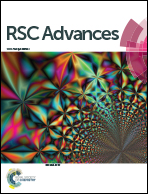In situ growth of small Au nanoparticles on ZnO nanorods via ultrasonic irradiation toward super-enhanced catalytic activity†
Abstract
The growth process of heterostructures affects their interface feature, which governs the property. In this study, small Au nanoparticles (NPs) were in situ grown on ZnO nanorods (NRs) via a sonochemical method without adding an external reducing agent, including H atoms and free electrons, because of the reducing species generated during sonication. Because of the close attachment of the AuNPs, the Au/ZnO heterostructures exhibit superior photocatalytic performance in degradation of Rhodamine B (RhB). Namely, the Au/ZnO NRs degrade RhB completely within 12 min. It is found that the improved photocatalytic activity mainly originates from the enhanced separation of electron–hole pairs because the Au NPs act as electron traps. Moreover, the Au/ZnO photocatalyst can be reused more than five times without significant deactivation. The study of CO oxidation demonstrates that the Au/ZnO catalysts display enhanced catalytic activity, which was ascribed to the deposited Au NPs providing more active sites. It was also found that the sonochemical method is applicable for the preparation of high quality Pt/ZnO heterostructures.


 Please wait while we load your content...
Please wait while we load your content...